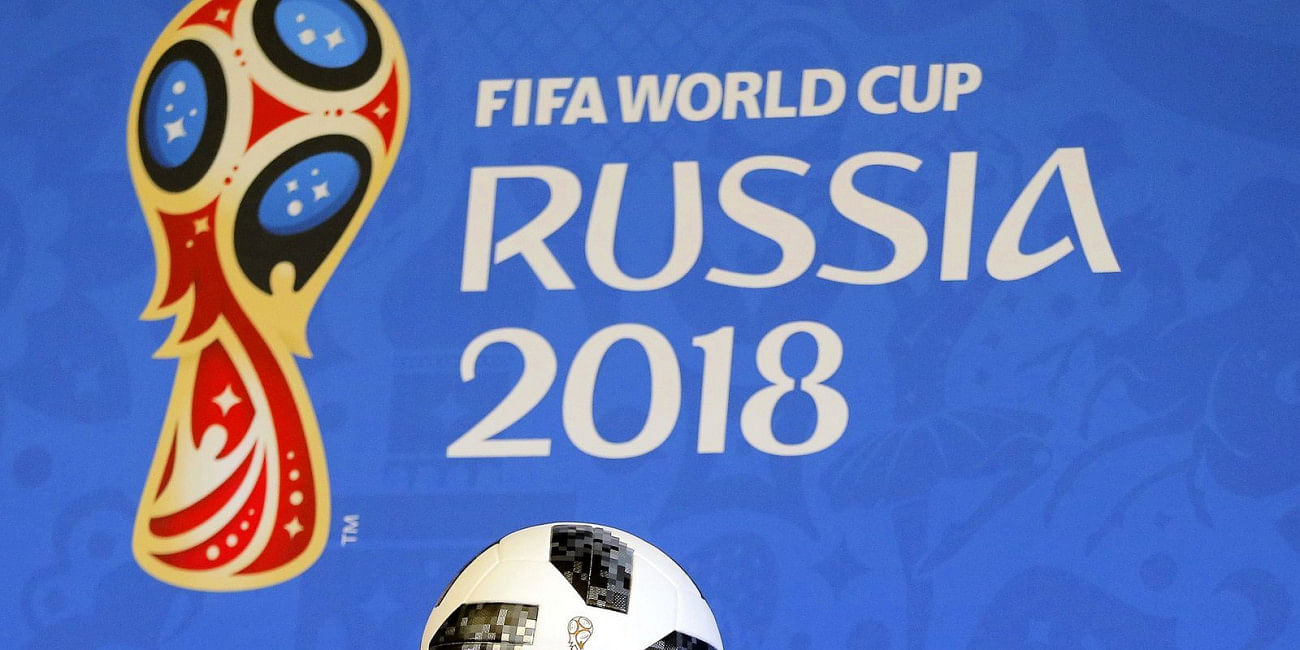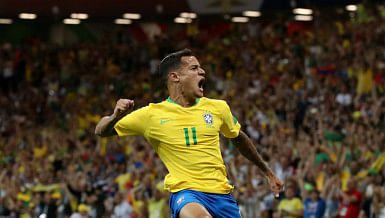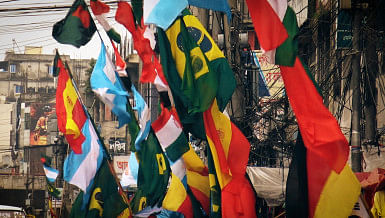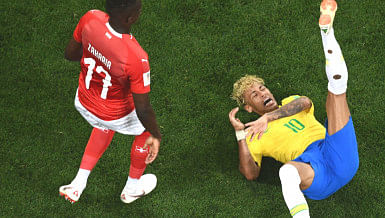The 2018 World Cup draw took place Friday at the Kremlin, which seemed as good a place as any to unveil valuable information of vital global interest. Here’s our live coverage and analysis from Moscow.
Group A: Russia, Uruguay, Egypt, Saudi Arabia
Group B: Portugal, Spain, Iran, Morocco
Group C: France, Peru, Denmark, Australia
Group D: Argentina, Croatia, Iceland, Nigeria
Group E: Brazil, Switzerland, Costa Rica, Serbia
Group F: Germany, Mexico, Sweden, South Korea
Group G: Belgium, England, Tunisia, Panama
Group H: Poland, Colombia, Senegal, Japan
Russia, England and France got favorable draws. Portugal will play its neighbor Spain in Group B, and Argentina drew one of the tougher first-round groups, as it was paired with Croatia, Iceland and Nigeria. Mexico, the Concacaf champion, will play Germany, Sweden and South Korea in Group F.
Group A analysis: balance, and two bad teams.
Teams: Russia, Uruguay, Egypt, Saudi Arabia
From Rory Smith in Moscow: The opening game of the World Cup will be Russia against Saudi Arabia: or, to put it another way, the two worst teams in the tournament, according to the FIFA rankings. The group is quite nicely balanced, though: Uruguay will expect to make the last 16, but both Russia and Egypt will have hopes of joining them.
Photo
Russia President Vladimir Putin, right, and FIFA President Gianni Infantino opened the draw. Putin, whose country is facing a doping ban from the Olympics, spoke about the spirit of “fair play” in welcoming all the entrants to Russia next summer. Credit Grigory Dukor/Reuters
Group B analysis: two favorites, and no guarantees.
Teams: Portugal, Spain, Iran, Morocco
From Rory Smith: Not as bad as it might have been for Portugal and Spain. Both will expect to make it through — though Morocco is not to be underestimated — in a group that also includes Iran. Finishing on top here might prove crucial as the tournament’s knockout round takes shape.
Continue reading the main story
ADVERTISEMENT
Continue reading the main story
Group C analysis: dream group for France.
Teams: France, Peru, Denmark, Australia
From Rory Smith: If France had imagined an ideal group, it would have been this. Peru was among the weakest of the second seeds, Australia does not have a coach, and Denmark should not trouble them too much. Second place could be intriguing, though.
Group D analysis: the most interesting group, for sure.
Teams: Argentina, Croatia, Iceland, Nigeria
From Rory Smith: Probably the most delicately balanced, most interesting, and most competitive of all the groups. Argentina only just qualified, Croatia has an abundance of individual talent, Iceland a tremendous collective strength and Nigeria was, possibly, the toughest fourth seed to draw. Argentina will not be happy at all.
Group E analysis: a battle for second?
Teams: Brazil, Switzerland, Costa Rica, Serbia
From Rory Smith: Brazil will not be nearly as happy as France, however. Serbia, Switzerland and Costa Rica is a relatively kind section for Tite’s team. The battle to join them in the last 16 will be absolutely fascinating, however: there is not much between those three teams. And there may not be many goals between them, either.
Group F analysis: the champions should be happy.
Teams: Germany, Mexico, Sweden, South Korea
From Rory Smith: Like France and Brazil, Germany has nothing to complain about: Sweden is hard-working but limited, and neither South Korea nor Mexico have the quality to derail the reigning champion.
Group G analysis: Two favorites and two sleepers.
Teams: Belgium, England, Tunisia, Panama
From Rory Smith: It should be a straight shootout between England and Belgium to see who claims the top spot and, with it, a theoretically easier second-round fate. The main advantage Panama and Tunisia have is that both will, to some extent, be unknown quantities.
Group H analysis: the most open group of all?
Teams: Poland, Colombia, Senegal, Japan
From Rory Smith: Along with Group A, Group H seems the most evenly spread. Poland was among the weakest top seeds, and Colombia will harbor ambitions of finishing first. Japan and Senegal, though, will both see the Round of 16 as a real possibility now.
Germany and Brazil installed as the early betting favorites.
No United States, so no World Cup for you? Not so fast there — you can make your viewing experience more vital with a bet on who’s going to win it all. The rest of the world can’t wait to hustle to the betting windows on the beautiful game’s premier showcase.
Germany and Brazil are the current 5-1 co-favorites, according to the British bookmaker Paddy Power, which also rates France (6-1), Spain (13-2) and Argentina (8-1) as serious contenders. The home team, Russia, is 33-1.
Iceland was given a 100-1 chance immediately after the draw, while Tunisia, Saudi Arabia and Panama were the longest shots on the board at 500-1.
Looking for a live longshot? How about our neighbor to the South: Mexico is 100-1.
The final pot as it was drawn.
Saudi Arabia (wow) goes in Russia’s group, which already looks to be the easiest.
Serbia completes Group E, with Brazil.
Morocco in with Portugal and Spain in Group B.
Australia goes in Group C with France, Peru and Denmark. France is thrilled, surely, and everyone else thinks they have a shot, too.
Nigeria in Group D with Argentina, Iceland and Croatia.
Panama (this could have been you, USMNT) goes into Group G, with Belgium, Tunisia and England. Not a terrible draw for their debut. Good draw for England, too.
Korea (in F) and Japan (in H) complete the field.
Let the second-guessing, predictions and analysis commence!
The field after three pots were emptied.
Group A: Russia, Uruguay, Egypt
Group B: Portugal, Spain, Iran
Group C: France, Peru, Denmark
Group D: Argentina, Croatia, Iceland
Group E: Brazil, Switzerland, Costa Rica
Group F: Germany, Mexico, Sweden
Group G: Belgium, England, Tunisia
Group H: Poland, Colombia, Senegal
Analysis from Rory Smith: Before the draw, Pot 3 looked slightly and counterintuitively less dangerous than Pot 4; that holds true. Argentina and Croatia will have been disappointed to have drawn Iceland, and Poland, Senegal and Colombia should be fascinating to watch. But most of the top seeds will have been pleased with what they will face: Spain and Portugal, who have Iran, in particular.
Photo
The former Brazil defender Cafu with Senegal’s slip. Senegal went into the final group, with Poland, Colombia and Japan. Credit Mladen Antonov/Agence France-Presse — Getty Images
On to Pot 3 now.
Egypt goes in with Russia and Uruguay in Group A.
Denmark is drawn next, but can’t go in Group B, so it’s place in C instead, with France. Ugh.
Iran fills the Group B spot.
Iceland is next out, in Group D with Argentina and Croatia. Harsh draw.
Costa Rica gets Brazil in Group E. That could have been you, America.
Sweden into Group F.
Tunisia with England, then Senegal.
A glance at the groups after two pots.
Group A: Russia, Uruguay
Group B: Portugal, Spain
Group C: France, Peru
Group D: Argentina, Croatia
Group E: Brazil, Switzerland
Group F: Germany, Mexico
Group G: Belgium, England
Group H: Poland, Colombia
Analysis from Rory Smith in Moscow: By far the biggest reaction inside the hall was seeing Portugal grouped with Spain, and with good reason. The Portuguese, it’s fair to say, have drawn the short straw among the top seeds.
Most of the others will be relatively happy: Brazil, Germany and France, the other major contenders, have avoided the worst of the traps. Belgium and England makes for a finely poised group. And Uruguay will be absolutely delighted to have drawn Russia.
Newsletter Sign UpContinue reading the main story
Marc Stein's Newsletter
He's covered Jordan. He's covered Kobe. And LeBron vs. the Warriors. Go behind the N.B.A.'s curtain with the league's foremost expert.
Enter your email address
Sign Up
You agree to receive occasional updates and special offers for The New York Times's products and services.
PRIVACY POLICY OPT OUT OR CONTACT US ANYTIME
On to Pot 2 now.
Uruguay is the first team out, and they get dropped in with Russia in Group A. (From Rory: So Russia get Uruguay from Pot 2. Or, more accurately, Uruguay get Russia, by far the easiest of the top seeds.)
Spain is next, and will play its neighbor Portugal in the first game in Group B.
Peru goes in Group C with France. Didier Deschamps is probably fine with that.
Croatia in with Argentina in Group D. That’s an unlucky draw for Messi and Co., made worse by Lineker cracking about Maradona being good with his hands as he pulls the team out. Ouch.
Switzerland into Group E with Brazil. Gulp.
Mexico thrown in with the Germans in Group F.
England in Group G with Belgium, and Colombia in H with Poland.
Here’s the field so far.
Group A: Russia
Group B: Portugal
Group C: France
Group D: Argentina
Group E: Brazil
Group F: Germany
Group G: Belgium
Group H: Poland
Pot 1 goes first.
Russia, as planned, is the first team out. It goes in Group A.
Portugal is next. The European champion goes in Group B.
France in Group C.
Argentina in Group D.
Brazil in Group E.
Germany, the World Cup and Confederations Cup champion, in Group F.
Belgium is in Group G.
Poland in Group H.
The hosts are on stage. Here we go.
Gary Lineker reads out the teams and explains the rules, extending the interminable wait a little longer.
Remember, Russia will be placed first, as team A1, and play in the opening game.
First singing, now dancing ....
We promise there will be a draw today.
Infantino passing out compliments.
Infantino, steps away from Putin, praises his host country, saying Russia is ”a welcoming country, a warm country.”
Though not today; it’s in the 30s and snowing outside the hall.
At long last, the draw is under way.
Not the picking of teams, mind you. That will still be about 20 minutes — after Russia’s president, Vladimir V. Putin, and FIFA’s president, Gianni Infantino, come onstage for speeches.
“The teams, the coaches, are all our friends,” Putin says.
Before we begin, a quick look at all 32 teams.
Unlike many who consume soccer for fun or for a living, Rory Smith of The Times is a big fan of draws, as he wrote in our weekly newsletter Thursday. (Related: you should definitely sign up for our weekly sports newsletter.)
“I love a draw,” Rory said. “I love the word ‘permutations.’ I love the sense that anything is possible. I love seeing that blank slate fill up. I love trying to work out what the best games will be and whose path to the semifinals, to the final, to glory, might be easiest and which most strewn with complication.
“And I love the mystery of the World Cup draw. We are saturated with soccer now: We can watch all of the world’s best players every week. Only at the World Cup do players from nowhere suddenly burst to life, and teams — Tunisia, Iran, even Russia itself — from isolated soccer cultures join the party. The draw is the start of that adventure into the unknown.”
Even if you don’t share Rory’s delight in a good draw, he broke down all 32 teams, this week, looking at their pasts, their paths and at what would qualify as a successful trip to Russia.
Diego Maradona has arrived, and he looks amazing.
Photo
Diego Maradona, a World Cup winner in 1986, and his girlfriend, Rocío Oliva, arrive at the draw. Credit Matthias Hangst/Getty Images
With an hour to go, a word about seeds.
The seeding this year is based on the FIFA world rankings. That’s controversial, because the rankings are far from universally accepted as the most accurate ordering of teams. The most contentious issue is that friendly games count in the rankings, although they are worth fewer points. Because team’s positions are based on average points per match, teams that play a lot of friendlies are penalized. Several sides, including Poland, seem to have gamed the system by playing fewer friendlies, which helped their ranking.
So before you ask: That’s why Poland, a fine team but hardly a tournament favorite, is in Pot 1.
Here’s what to expect today.
The draw will take much longer than it needs to take. It always does. FIFA budgets about an hour for a mix of performances, speeches and, amid much social media grumbling, the draw itself.
This will be the first draw in a generation that will not take place under the usually benign (but not always) awkwardness of Sepp Blatter, who served as FIFA’s president from 1998 until he was ousted amid a corruption scandal two years ago. Gianni Infantino, who replaced Blatter as president in 2016, is FIFA’s top man now.
The World Cup kicks off June 14, with Russia’s first game, in Moscow. It concludes there on July 15. Germany is the defending champion. No team has repeated as world champion since Brazil, in 1958 and 1962.
The 32 teams who qualified for the World Cup already have been seeded according to the FIFA rankings (cue more grumbling) and divided into four pots. The breakdowns:
Pot 1: Russia, Germany, Brazil, Portugal, Argentina, Belgium, Poland, France
Pot 2: Spain, Peru, Switzerland, England, Colombia, Mexico, Uruguay, Croatia
Pot 3: Denmark, Iceland, Costa Rica, Sweden, Tunisia, Egypt, Senegal, Iran
Pot 4: Serbia, Nigeria, Australia, Japan, Morocco, Panama, South Korea and Saudi Arabia
—-
Want the big sports news, highlights and analysis from a rotating cast of Times journalists, delivered to your inbox once a week? Click here to receive our weekly Sports newsletter.
—-
Don’t follow the World Cup unless the United States is playing? Well, have we got a surprise for you ….
A news conference about the draw focused on Russian doping.
FIFA President Gianni Infantino held a pre-World Cup draw news conference Friday, but the topic of the draw barely came up. Instead, Infantino, appearing with Russia’s deputy prime minister, Vitaly Mutko, who leads the country’s World Cup organizing committee, spent more than an hour uncomfortably, and at times angrily, fending off questions about Russia’s doping scandal.
Infantino tried to distance FIFA, and the World Cup, from the accusations, which could see Russia banned from the Olympics next week — only months before the country hosts the World Cup. Mutko, formerly Russia’s sports minister and still the head of Russia’s soccer federation, was more combative.
FIFA President Gianni Infantino, right, appeared with Russia's deputy prime minister, Vitaly Mutko, at a news conference ahead of Friday's World Cup draw in Moscow. But almost no one asked about the draw; instead, most of the questions were about Russia's doping scandal. Credit Sergei Chirikov/European Pressphoto Agency
Mutko has been implicated in what has been described by whistleblowers and investigators as a massive state-sponsored doping plan, but on Friday he angrily rebutted the accusations and vowed that Russia “will take a firm position and will defend its athletes until the bitter end.”
“There is no proof,” Mutko said at one point.
Infantino also was asked about the ongoing trial in Brooklyn of three former soccer officials who were charged in FIFA’s own broad corruption scandal in 2015, but said he would not comment on “things that are not proven.” Witnesses at the trial have testified about payments from Qatar to FIFA officials to win the rights to host the 2022 World Cup




 For all latest news, follow The Daily Star's Google News channel.
For all latest news, follow The Daily Star's Google News channel. 









Leave your comments